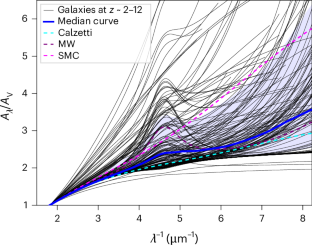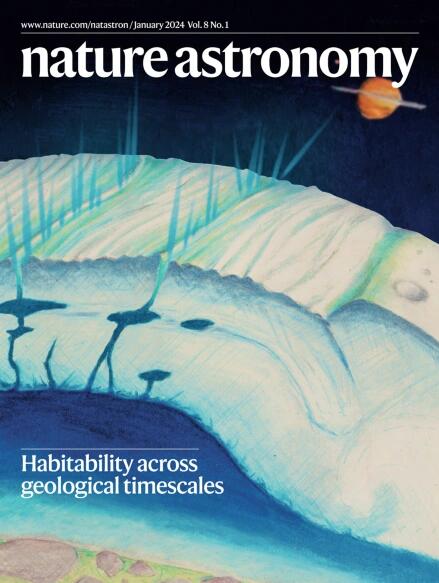JWST观测z≈2-12星系中尘埃衰减的演化
IF 12.9
1区 物理与天体物理
Q1 ASTRONOMY & ASTROPHYSICS
引用次数: 0
摘要
星系中恒星合成的重元素中有相当一部分凝结成亚微米大小的固态粒子,即尘埃颗粒。尘埃对星系发射产生波长相关的衰减,即λ,从而大大改变了观测到的特性。在局部,λ通常是幂律和小碳基颗粒产生的紫外线特征(“凹凸”)的总和。然而,关于它在宇宙时间内的演化信息很少。本文利用詹姆斯·韦伯太空望远镜在红移范围z = 2-12内观测到的173个星系的数据,我们报告了在z≈7.55星系(宇宙年龄仅为~700 Myr)中探测到的紫外线碰撞,并表明幂律斜率和碰撞强度向高红移方向下降。我们认为,早期扁平的λ形是由超新星喷出物中新形成的大颗粒形成的,这些大颗粒是早期主要的尘埃工厂。重要的是,由于可用的宇宙时间有限,这些颗粒在星际介质中经历了最小的再加工。这一发现为尘埃衰减特性的红移依赖演化提供了至关重要的见解,揭示了超新星驱动的尘埃产生的作用,早期宇宙时期的颗粒大小分布以及后来时代驱动尘埃演化的过程。本文章由计算机程序翻译,如有差异,请以英文原文为准。


The evolution of dust attenuation in z ≈ 2–12 galaxies observed by JWST
A sizable fraction of the heavy elements synthesized by stars in galaxies condenses into submicrometre-sized solid-state particles known as dust grains. Dust produces a wavelength-dependent attenuation, Aλ, of the galaxy emission, thereby substantially altering its observed properties. Locally, Aλ is in general the sum of a power law and a ultraviolet feature (‘bump’) produced by small, carbon-based grains. However, scant information exists regarding its evolution across cosmic time. Here, leveraging data from 173 galaxies observed by the James Webb Space Telescope in the redshift range z = 2–12, we report the detection of the ultraviolet bump in a z ≈ 7.55 galaxy (when the Universe was only ~700 Myr old) and show that the power-law slope and the bump strength decrease towards high redshifts. We propose that the flat Aλ shape at early epochs is produced by large grains newly formed in supernova ejecta, which act as the main dust factories at such early epochs. Importantly, these grains have undergone minimal reprocessing in the interstellar medium due to the limited available cosmic time. This discovery offers crucial insights into the redshift-dependent evolution of dust attenuation properties, shedding light on the role of supernovae-driven dust production, grain size distribution at early cosmic times and the processes driving dust evolution at later epochs. This study presents the evolution of the dust attenuation curve in galaxies over cosmic time, suggesting that dust attenuation at early times is dominated by large grains from supernovae. The study also reports an ultraviolet bump in a source at redshift z ≈ 7.5.
求助全文
通过发布文献求助,成功后即可免费获取论文全文。
去求助
来源期刊

Nature Astronomy
Physics and Astronomy-Astronomy and Astrophysics
CiteScore
19.50
自引率
2.80%
发文量
252
期刊介绍:
Nature Astronomy, the oldest science, has played a significant role in the history of Nature. Throughout the years, pioneering discoveries such as the first quasar, exoplanet, and understanding of spiral nebulae have been reported in the journal. With the introduction of Nature Astronomy, the field now receives expanded coverage, welcoming research in astronomy, astrophysics, and planetary science. The primary objective is to encourage closer collaboration among researchers in these related areas.
Similar to other journals under the Nature brand, Nature Astronomy boasts a devoted team of professional editors, ensuring fairness and rigorous peer-review processes. The journal maintains high standards in copy-editing and production, ensuring timely publication and editorial independence.
In addition to original research, Nature Astronomy publishes a wide range of content, including Comments, Reviews, News and Views, Features, and Correspondence. This diverse collection covers various disciplines within astronomy and includes contributions from a diverse range of voices.
 求助内容:
求助内容: 应助结果提醒方式:
应助结果提醒方式:


